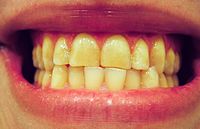
Photo from wikipedia
The effects of wearing an intra-oral device on several ventilatory and fatigue markers have been reported for a variety of sports. The quality of the figures performed in synchronized swimming… Click to show full abstract
The effects of wearing an intra-oral device on several ventilatory and fatigue markers have been reported for a variety of sports. The quality of the figures performed in synchronized swimming is directly affected by fatigue, and can be monitored during training sessions (TS). The aim of the study was to investigate the acute effects of wearing customized intra-oral devices on heart rate variability, rating of perceived exertion, blood lactate accumulation, and salivary cortisol production during a competitive training session. Twelve highly trained elite female athletes (age: 21.0±3.6 years) participated in the study. Fatigue markers were assessed at the beginning and at the end of the 3rd and 5th afternoon TS for that week, once with and once without an intra-oral device, in random order. Salivary cortisol levels were higher in relation to the baseline in the intra-oral device condition (P<0.05) but not in athletes without an intra-oral device. No differences between conditions were found in rating of perceived exertion (P=0.465) and blood lactate (P=0.711). No time or condition interactions or main effects were shown for heart rate variability. Thus, there is no evidence that wearing a low-arch intra-oral device is a good recommendation for high-standard athletes performing long and stressful routines.
Journal Title: International journal of sports medicine
Year Published: 2020
Link to full text (if available)
Share on Social Media: Sign Up to like & get
recommendations!